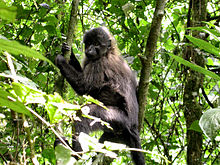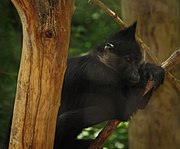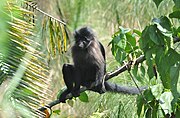
The guenons are Old World monkeys of the genus Cercopithecus. Not all members of this genus have the word "guenon" in their common names; also, because of changes in scientific classification, some monkeys in other genera may have common names that include the word "guenon". Nonetheless, the use of the term guenon for monkeys of this genus is widely accepted.

Talapoins are the two species of Old World monkeys classified in genus Miopithecus. They live in central Africa, with their range extending from Cameroon and the Democratic Republic of the Congo to Angola.

The golden-bellied mangabey is a social Old World monkey found in swampy, humid forests south of the Congo River in the Democratic Republic of the Congo. It was previously considered a subspecies of the agile mangabey . Little is published about the species and its behaviour has only been studied in captivity.

The grey-cheeked mangabey, also known as the white-cheeked mangabey, is an Old World monkey found in the forests of Central Africa. It ranges from Cameroon down to Gabon. The grey-cheeked mangabey is a dark monkey, looking in shape overall like a small, hairy baboon. Its thick brown fur is almost black in its forest home, with a slightly rufus/golden mane around the neck. The sexes are similar, with the males slightly larger than the females.

Mangabeys are West African Old World monkeys, with species in three of the six genera of tribe Papionini.

The sooty mangabey is an Old World monkey found in forests from Senegal in a margin along the coast down to the Ivory Coast.
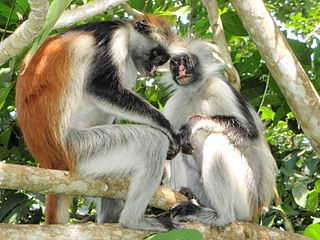
Red colobuses are Old World monkeys of the genus Piliocolobus. It was formerly considered a subgenus within the genus Procolobus, which is now restricted to the olive colobus. They are closely related to the black-and-white colobus monkeys, and some species are often found in groups with the blue monkey. The western red colobus is frequently hunted by the common chimpanzee.
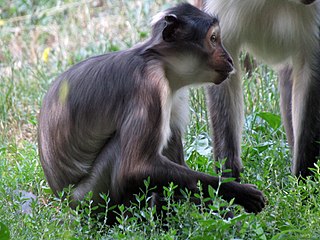
The white-eyelid mangabeys are African Old World monkeys belonging to the genus Cercocebus. They are characterized by their bare upper eyelids, which are lighter than their facial skin colouring, and the uniformly coloured hairs of the fur. The other two genera of mangabeys, Lophocebus and Rungwecebus, were once thought to be very closely related to Cercocebus, so much so that all the species were placed in one genus, but Lophocebus and Rungwecebus species are now understood to be more closely related to the baboons in genus Papio, while the Cercocebus species are more closely related to the mandrill.
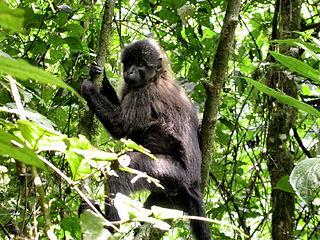
The Uganda mangabey is a subspecies of the grey-cheeked mangabey, an Old World monkey, found only in Uganda and in the Minziro Forest Reserve, just over the border in Tanzania. Colin Groves upgraded the Ugandan population of this crested mangabey to the new species L. ugandae on 16 February 2007, but this is not widely accepted. This subspecies is significantly smaller than the other subspecies of grey-cheeked mangabey, with a shorter skull and smaller face. 2018 was the most recent year in which the International Union for Conservation of Nature assessed the conservation status of L. albigena ugandae, describing it as being of vulnerable.

The collared mangabey, also called red-capped mangabey and white-collared mangabey, is a species of primate in the family Cercopithecidae of Old World monkeys. It formerly included the sooty mangabey as a subspecies. As presently defined, the collared mangabey is monotypic.

The black crested mangabey is a species of primate in the family Cercopithecidae. It is only found in Democratic Republic of the Congo with a small habitat extending to Angola. Its natural habitat is subtropical or tropical dry forests. It is threatened by habitat loss.

The agile mangabey is an Old World monkey of the white-eyelid mangabey group found in swampy forests of Central Africa in Equatorial Guinea, Cameroon, Gabon, Central African Republic, Republic of Congo, and DR Congo. Until 1978, it was considered a subspecies of the Tana River mangabey. More recently, the golden-bellied mangabey has been considered a separate species instead of a subspecies of the agile mangabey.

The Sanje mangabey is a highly endangered Old World monkey of the white-eyelid mangabey group from the Eastern Arc Mountains in Tanzania. They are about 50–65 centimetres (20–26 in) in length, excluding the tail, and their body colour is greyish. Fruit makes up about 70% of their diet. They live in valley forests and on mountain slopes, but are mostly ground-dwelling, which makes them susceptible to hunting and poaching. Their habitat is being degraded, and the International Union for Conservation of Nature has assessed their conservation status as being "endangered".
Opdenbosch's mangabey is a subspecies of crested mangabey in the family Cercopithecidae. It has also been treated as a full species. It is found in the Democratic Republic of the Congo.
Johnston's mangabey is a subspecies of the gray-cheeked mangabey, a crested mangabey in the family Cercopithecidae. It was elevated to full species status in 2007, alongside Osman Hill's mangabey and the Uganda mangabey, but is still generally considered as a subspecies.

The Osman Hill's mangabey, also known as the rusty-mantled mangabey, is a subspecies of the grey-cheeked mangabey, a crested mangabey in the family Cercopithecidae, with a restricted distribution in West Africa.

Allochrocebus is a primate genus including the terrestrial guenons: the L'Hoest's monkey, the Preuss's monkey, and the sun-tailed monkey.

The white-naped mangabey is a species of Old World monkey in the subfamily Cercopithecinae. The species is found in the forest of Burkina Faso, Ghana and Ivory Coast. The species population has been declining due to deforestation and hunting and has thus been put as an endangered species by the International Union for Conservation of Nature. The species was once considered a subspecies of the sooty mangabey but is now a separate species. This species had previously been regarded as a subspecies of Cercocebus atys, but was later raised to species status.
